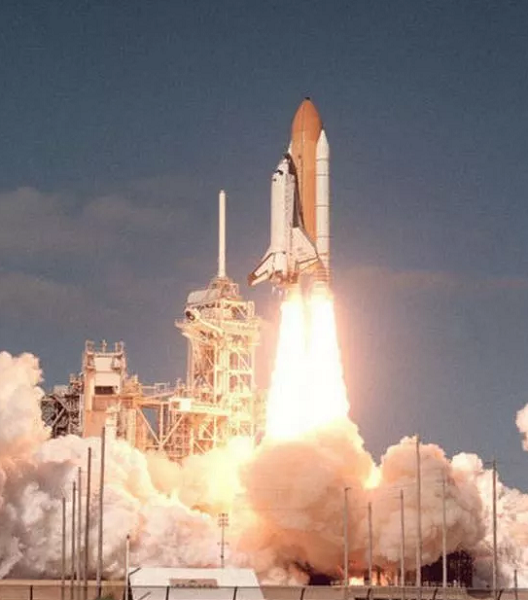





The Space Shuttle That Fell to Earth is a three part documentary that marks the anniversary of the Columbia disaster, when the US space shuttle disintegrated on the return journey of its 28th mission, killing all seven astronauts on board. There are interviews with family and friends of the lost cosmonauts and an examination of what went wrong, unpicking the failures of Nasa.
The shuttle took off on 16 January 2003 at 9.39am Orlando, Florida and disintegrated on 1 February 2003 at 8.59am EST over Texas and Louisiana. Both take off and descent took place under the unyielding, can-be-destructive Saturn opposition Pluto which for take off and disintegration was square the Pisces Ascendant. This Saturn Pluto opposition was around for 9/11, the Afghanistan and Iraq wars. On the take off chart there was also an ominous Mars in last degree Scorpio square Uranus and Sun conjunct the fixed star Procyon (= can raise to great heights and bring crashing down). When the crash occurred the Sun had moved to conjunct the Neptune and was moving to oppose the overly optimistic Jupiter in Leo.
As to be expected the Columbia Disaster chart has a high-risk/destructive 16th harmonic with the Sun linked to Mars and Pluto; and both Mars and Pluto on the focal points of yods. The 18th harmonic was also notably super-stressed and dangerous with Mars opposition Pluto.
The take off chart had similarly Mars, Pluto heavy aspects on its 16th and 32nd harmonic.
The Challenger disaster of 28 January 1986 when a shuttle exploded on take off killing all on board occurred at 11.38am off Cape Canaveral, Florida. Mars in late Scorpio was opposition Algol and the Sun was square Pluto. Again the 16th and 32nd Harmonic were marked. Even more so was the 18th harmonic with a fearsome Mars Pluto opposition Saturn which has associations with ‘fires and explosion’ in numerology.
Looking at other disasters: Both 9/11 and the Hiroshima bomb had marked 16H, 18H and 32H harmonic charts.
The Titanic sinking is interesting – from a ghoulish point of view. In that the hull-laying chart is almost the most indicative of what is to come, 31 March 1909. It had a Mars Uranus conjunction which had moved to exact by Solar Arc direction over the sinking. With a catastrophe and accident prone 16th harmonic with Mars linked to Saturn, Pluto. The chart of the sinking itself 14 April 1912 11.40pm is also indicative of being at risk of sudden violent calamities. At that point tr Neptune had moved to cross over the Mars Uranus conjunction which suggests panic and failure.
Both charts had marked 16H, 18H, and 32H charts. And what is a fascinating sidelight they both had strong 10th harmonics = rise and fall, hinting at over-confidence and too much stress being put on appearances.
After-the-event accidents are interesting from an astrological viewpoint; but only the Titanic disaster had a hope of being prevented if the astrology had been understood. Space Shuttles tend not to have hull-laying moments so only the take off is available.

If I remember correctly, Florida has two time zones.
My bad on fishing charts out of old files and not double checking – since even birthdates and times change over the years as new info emerges. Since I wasn’t using midheaven or ascendant the time/place would not change the harmonics astrology which is what the piece was about. Have amended the charts.
On astronauts cosmonauts – this is an argument for another place. I only used cosmonaut since astronaut had appeared in the previous sentence and I dislike repeating.
But I have a thing about words and common usage. In the psychological world, certain commonly used words have a specific clinical meaning when used in a professional setting. Ego for instance – to joe/jill public means overblown pain in the teeth. In psychology means basic necessity for staying sane. Cosmonaut may be a red flag for NASA insiders but for your average outsider the distinction is not so clear cut. Whichever refers to persons flying through space.
I’m only labouring the point since I am increasingly getting irked by all the jargon, acronyms and the like thrown around in heated discussions. Bystanders are supposed to be read into the fine distinctions of this label or that label, otherwise a typhoon of bile is released.
Accuracy is important but elitist or tribal insistence that those who don’t understand the intricacies of their communication system and shorthand are ignorant peasants does get a touch wearing.
Filling in my remark on the disaster chart: With the Shuttle coming in at thousands of miles an hour, the exact spot of breakup isn’t known. Pieces already were coming off when the orbiter was over California. Final communication received was when the orbiter was over north Texas. Houston is hundreds of miles away in south Texas.
https://spaceflightnow.com/shuttle/sts107/030218caib/
“Columbia was in a left bank at the time, descending at Mach 18 over northwest Texas at an altitude of more than 200,000 feet. While the exact timing is still unclear, time-stamped video from an Apache helicopter flying near Fort Hood, Texas, shows multiple contrails by 9:00:30 a.m., indicating Columbia broke completely apart less than a minute after the last valid data frame was downlinked.”
https://flightpaths.lib.purdue.edu/blog/2016/06/30/picking-up-the-pieces/
Chart 2 shows loss of signal (“last valid data frame” mentioned above) at 13:59:51 when the orbiter was at 32.9 North 99.8 West.
“…where the most of the debris was eventually found. This area spanned across more than 2,400 square miles of Texas and Louisiana, larger than any other previous accident site.”
V2: not clear at all what you are trying to clarify. Many people have followed this particular disaster for yrs. Lots of data is available.
Is there an urgency to discovering the precise time of disintegration?
Previous Shuttle post-flight inspections clearly identified internal wing burn-thru damage. Also, there was an onboard flight data recorder, never removed after the initial test flights, which recorded every aspect of the disintegration, depending of course if the associated sensors were still working.
Frankly, dead is dead. Pick up the pcs and go home and hopefully try once again.
Marjorie, “Astronauts cosmonauts – does it matter?”
No more than randomly using the official Russian word for anything else. It would make as much sense to say James Bond is the star of Шпио́н stories. “The sphion ubiytsa sipped his мартини while he read the Guardian’s redaktor’s essay about the death of Tsarina Elizabeth II.” Does it matter? It means the same thing…
Some of my Dad’s equipment was used when astronauts and cosmonauts shook hands in space, when I was a child. At the time of Apollo-Soyuz, the words and what they meant mattered very much.
Cosmonaut has always been the Russian word for those in their own space program, not used anywhere else. Why arbitrarily replace the job title used by NASA and all their own space workers, for the one only used by another nation’s program to refer only to their own staff?
Larry, there are a lot of Marjorie’s write ups where I don’t know anything about the situation. Especially details of the UK Royals, and other subjects of Tsar Charles who are less famous across the pond. This one I do happen to know about.
If places are off by hundreds of miles and times by hours, that invalidates much of the astrology. Precise times and places are known for the five biggest disasters in NASA’s history, directly from them. North Texas to south Texas is as far apart as Aberdeen to Plymouth. What would be the response if I as a yankee said Brighton is a perfectly good substitute for Inverness in any chart, since they’re both on the British shore?
Why not use accurate information direct from the source, rather than a clear mix-up like putting Orlando on the coast, or having the wrong time and time zone? If one’s going to do a round-up of biggest NASA disasters, here they are with links on one page, direct from the source.
I don’t mean to be contentious. I would like to see accuracy rather than misunderstandings, about something I do know about. People will find the accurate information useful, or not. I’ll move on from the topic now.
Thanks. No issue on this side of the colonies.
That original tape recorder did somehow survive re-entry. The time stamps would be important to understand how disintegration progressed.
Was a time, yrs ago, I maintained some of that stuff on the shuttle. Some stuff was removed from hard drives. EVentually the hard drives were replaced.
John and Linda are right. I’m surprised at how far wrong the article is. My Dad worked for NASA. Although he didn’t work on the Space Shuttle we kept current on NASA news with many public NASA documents he brought home to share. Cosmonaut was the Russian version of the word. The world only used it when referring to astronauts working for the Russian space program.
See NASA’s links to the X-15, Apollo 1, Apollo 13, Challenger, and Columbia disasters, at https://www.nasa.gov/headquarters/library/find/bibliographies/american-human-spaceflight-accidents/
The Apollo and then Space Shuttle launch facility at Kennedy Space Center is often called “the Cape.” Cape Canaveral is on the ocean, clearly shown in all news coverage of launches. Orlando is 75 miles away, inland. Orlando has nothing to do with the space program. Columbia’s launch was 10:39 am Eastern time from KSC, not an hour earlier in Orlando. Your chart for the launch isn’t valid for either place or time.
Columbia’s breakup was as it re-entered the atmosphere over Texas, hundreds of miles away from Florida, at 9:00 am Eastern time, which is 2:00 pm UTC. Your chart for the breakup also isn’t valid for either place or time.
Columbia timeline shows precisely 9:00:15 EST for the orbiter’s breakup.
Challenger is the one that blew up near where it launched, because that explosion was just 73 seconds after its launch from the Cape. 11:39 a.m. EST January 28, 1986. https://www.nasa.gov/history/rogersrep/v1ch3.htm
Out of these five incidents, only Apollo 13 was survived with all three astronauts safely returned to Earth. Apollo 13’s problems began 180,000 miles from Earth, so it would make sense to use Eastern time as the launch was from the Cape.
Apollo 1 fire was 6:37 am Eastern time at the Cape. Panel discussion on it at https://www.nasa.gov/podcasts/houston-we-have-a-podcast/apollo-1-fire/
X-15 summary at https://www.nasa.gov/history/x15/adams.html. Breakup location and time are given: northeast of the town of Johannesburg, California (the town’s at 35°22′22″N 117°38′05″W), 10:40 am Pacific time 15 November 1967.
Astronauts cosmonauts – does it matter? Its perfectly clear to normal people what it refers to. The charts were pulled out of old files so the times may have been adjusted since then – but even with time changes it won’t affect the harmonic charts much. I will look tomorrow.
“The shuttle took off on 16 January 2003 at 9.39am Orlando, Florida [sic] and disintegrated on 1 February 2003 at 2am UTC in Orlando.”
Actually, the shuttle took off from the Kennedy Space Centre just north of Cape Canaveral, Florida, the latter’s coordinates being listed in a Wikipedia entry as 28 degrees, 28 minutes North 80 degrees 32 minutes West.
Orlando is further inland, its coordinates listed in a Wikipedia entry as 28 degrees, 32 minutes, 24 seconds North 81 degrees 22 minutes 48 seconds West.
I just wondered why you referred to them as cosmonauts, as in 1986 the USSR had a sort of autonomy over tgat job description.
Is there a similar chart for the Apollo 1 fire? It burned during a launch pad test on January 27, 1967 at Cape Camaveral.